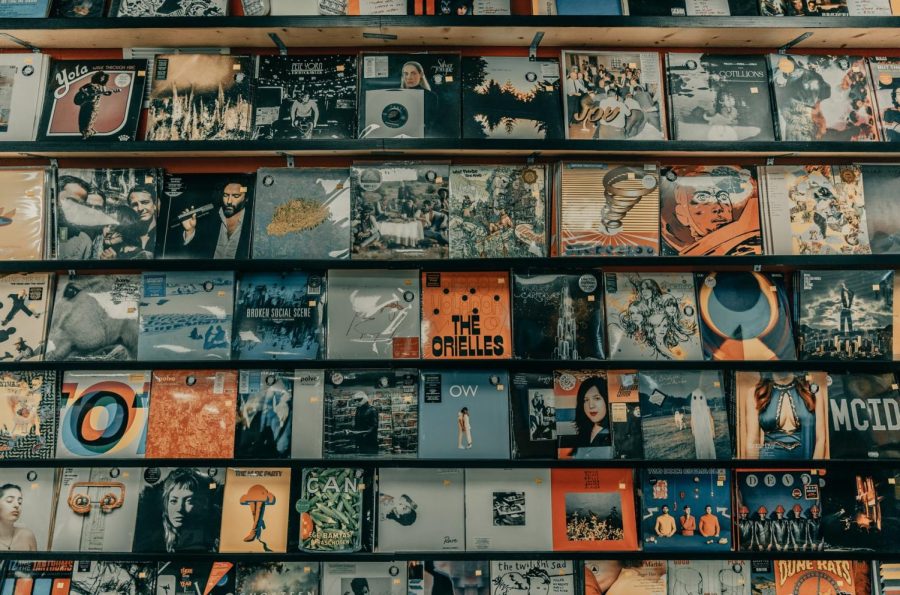Digital vs Analog Music
February 9, 2022
Since the resurgence of vinyl records in the 2010s, this form of music has become increasingly popular. Now, everyone from hipsters to high school students has their own turntable and vinyl collection. This vinyl revival brought back a long-time debate, is digital music worse or better than analog? I believe the future is in digital music, but vinyl records are still a treasure I have the pleasure of collecting.
The first phonautograph was invented by Leon Scott in 1857; it used a vibrating diaphragm and stylus to record sound waves without any intent of playing them back. Fast forward to 1901 and the first 10-inch disc records were introduced, then 12-inch records in 1903. The records of 1909 had a maximum playing time of 4.5 minutes at 80 rpm.
In 1930, RCA Victor launched the first Long-Playing records (LP’s). They were made of a variety of materials, including hard rubber and shellac. Even in the 1930s they were expensive; the LP’s were a commercial failure because they weren’t affordable during the Great Depression. In 1939, Columbia Records continued to develop this technology, and the vinyl record has been improved upon ever since.
There’s no denying the charm of vinyl records; they make music more personal. Instead of clicking ‘play’ on your computer or phone, you physically have to interact with the music. In our fast-paced modern world, it’s nice to think that people will take time out of their day to simply play a record.
Along with the record you get to watch spin, the sleeve is also a treat. Vinyl sleeves are fun decor for any room; they’re literally art. Some sleeves, like the Led Zeppelin III, are interactive, which makes them even better.
Unfortunately, there are multiple downsides to these trendy records. First, vinyl records aren’t very economical. If you’re a collector, vintage records can cost anywhere from $0.50 to $50. A $50 record from 1960 might not even be playable (always check before you buy). For a new record, the price ranges from $10 to $30. The price of new records doesn’t sound too bad, but you also need a turntable to actually play your records. The popular Victrola ‘suitcase’ record players range from about $45 to $55. With multiple records and a turntable, these prices definitely add up.
Vinyl records also aren’t eco-friendly; the production process involves toxic acids and consumes a lot of energy for steaming and cooling. On the upside, records rarely end up in landfills due to their function. They’re usually resold, or melted down and reused.
Digital music is the opposite, it’s eco-friendly, and affordable. It’s also cherishable if you obsessively make Spotify playlists like I do. Digital music is amazing for the consumer, but often not fair to the artist. For example, Spotify.
Spotify music earns two kinds of royalties, recording and publishing royalties.
Recording royalties are “The money owed to rightsholders for recordings streamed on Spotify, which is paid to artists through the licensor that delivered the music, typically their record label or distributor.”
Publishing royalties are “The money owed to songwriter(s) or owner(s) of a composition. These payments are issued to publishers, collecting societies, and mechanical agencies based on the territory of usage.”
Usually, Spotify pays rights holders between $0.003 to $0.005 per stream on average. About 70% of the stream revenue goes to the rightsholder, and 30% of all revenues generated goes to Spotify. For 1 million streams the rights holders would make $3,300 to $3,500. Keep in mind the rightsholder isn’t always the artist. Often the musician makes more money from vinyl sales than internet streaming.
“In the past three years, vinyl sales in the U.S. have steadily risen about $2 million annually,” wrote Seppala at engadget.
Even though vinyl is having a resurgence, digital is still the way most people get their music. It’s much more efficient than having to switch out records after every album. Digital music also allows you to listen to your favorite songs anywhere; around school, in the car, in the middle of nowhere.
That being said, digital music isn’t as fun as vinyl. With this material format, you get to literally touch the music. Plus, your record might come with a fun poster.
Both mediums have their pros and cons, but I’m very happy to live in a time where I can switch between the two.
Photo courtesy of UNSPLASH.COM

